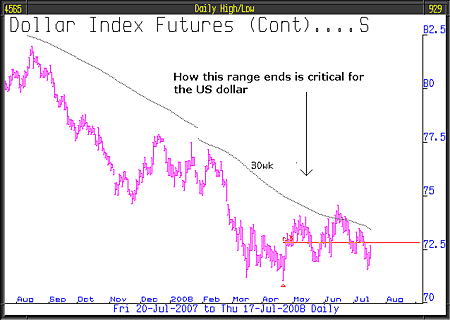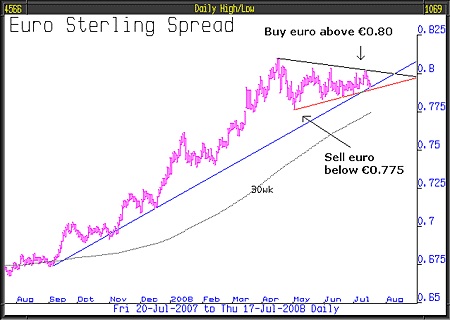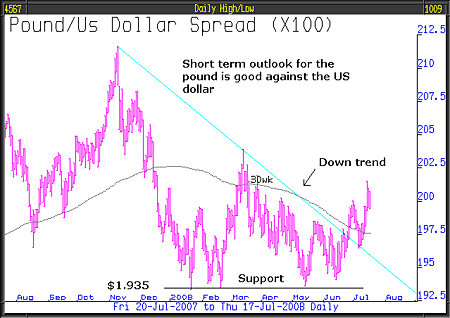The United Arab Emirates is currently suffering inflation of 11%, much of which is because of their dollar peg. Others with pegged or managed currencies are in a similar plight. On a day-to-day basis it seems quite unlikely that they will unpeg, however, common-sense says they must - a Sword of Damocles hangs over the dollar.
The problems surrounding Fannie and Freddie are a huge risk to the US dollar as is the worry that other banks will follow the IndyMac route and fail outright. All of that pressure on banks will get worse as the US housing market gets worse, which it will. We see no reason to change our view that dollar weakness will continue.
For the short term, the chart for the dollar index provides a very handy reference point. It has been in a trading range since March, currently in the lower half of that range. As we have said many times before, such moments offer unique forecasting opportunities. The eventual end of this range, which is inevitable, will define the future direction of the dollar. The longer it takes for that range to end, and sometimes they can go on for years, the more emphatic the signal. If, for example, it was to last another six months and then be followed by a break to the upside, we would consider that to be a medium to long term signal for dollar strength. If it happened soon, it would be a short to medium term signal. Failure at the lows of the range would be a signal that the long term dollar bear market was continuing.
MoneyWeek
Subscribe to MoneyWeek today and get your first six magazine issues absolutely FREE

Sign up to Money Morning
Don't miss the latest investment and personal finances news, market analysis, plus money-saving tips with our free twice-daily newsletter
Don't miss the latest investment and personal finances news, market analysis, plus money-saving tips with our free twice-daily newsletter

Given the seriousness of the banking crisis, Bernanke seems to be more concerned about the downside risk to the economy than the upside risk of inflation. He has made a study of economic history and knows that, at this point, one wrong step and it could be a deflationary slump. Because of that, in our view, the more likely tendency is for further interest rate easing by the Fed, not tightening the same applies to the UK!
Since March a fascinating range for euro/sterling has formed. We have the technical coincidence of the range, going sideways, coming into contact with the uptrend from a year ago. It would not surprise us one little bit to see the euro from here break to the upside against sterling. Above 0.8 the euro is a one-way bet which would also give added value to portfolio holdings of German government bunds. Conversely, a break below 0.775 would be very negative for the euro we might well then sell the German bunds.

Our technical reading of the pound/US dollar is biased towards sterling strength. As long as the support level of $1.935 holds, short term, sterling is positive. The pound/US dollar has recently broken above the down trend, having held at support.

On studying the important currency charts, one is left with the feeling that something big will happen soon. That something big is probably a sharp deterioration of the dollar and that will probably be as a result of further deterioration in the US housing and banking sectors - this, in spite of the actions of Ben Bernanke's Fed and Hank Paulson's US Treasury. We are watching the dollar index chart all of the time.
By John Robson & Andrew Selsby at Full Circle Asset Management ,as published in the threesixty Newsletter .
Get the latest financial news, insights and expert analysis from our award-winning MoneyWeek team, to help you understand what really matters when it comes to your finances.
MoneyWeek is written by a team of experienced and award-winning journalists, plus expert columnists. As well as daily digital news and features, MoneyWeek also publishes a weekly magazine, covering investing and personal finance. From share tips, pensions, gold to practical investment tips - we provide a round-up to help you make money and keep it.
-
 Zoopla: house price growth stalled in 2025 but forecasts for 1.5% higher next year
Zoopla: house price growth stalled in 2025 but forecasts for 1.5% higher next yearSales soared this year with more than a million deals done but buyers drove hard bargains keeping a lid on prices. A small bounceback in valuations is predicted for 2026, depending on where you live.
-
 UK sets out crypto regulatory proposals
UK sets out crypto regulatory proposalsThe government has tabled legislation that sets out a regulatory framework for cryptocurrencies, while the regulator will consult on balancing innovation and consumer protections

